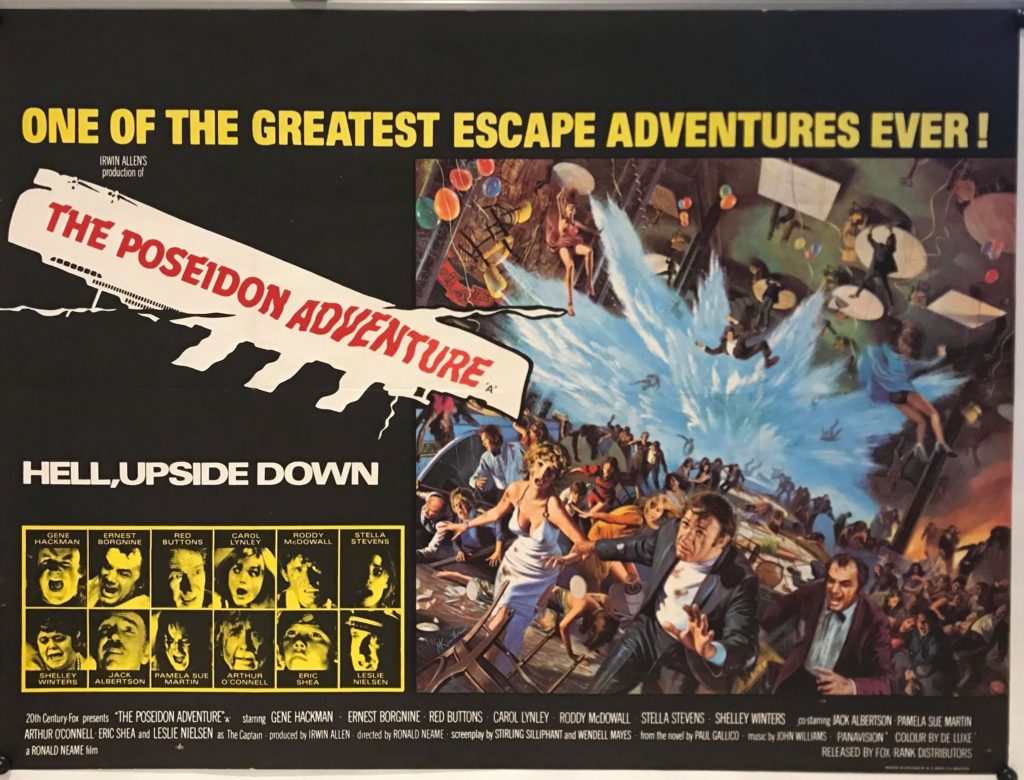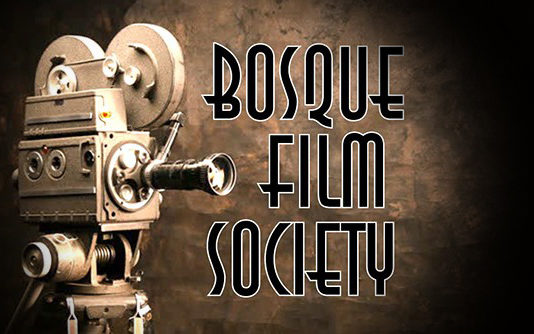Set on New Year’s Eve, “The Poseidon Adventure” launches disaster film craze of the 1970s
by BRYAN DAVIS
Bosque Film Society Historian
In the summer of 1973, I was a 14-year-old high school freshman. I had $100 burning a hole in my pocket from scraping an old two-story house preparing it for a new paint job. That was more money than I thought I could ever spend in a lifetime. My dad instructed me to invest it wisely. Instead, I bought Clearasil and binged on buttered popcorn and Dr. Peppers while watching Irwin Allen’s star-studded box office bonanza, “The Poseidon Adventure,” seven times.
That’s right…seven times.
 My sweet mom took me opening weekend during Christmas break in 1972 to the 25th Street Theater in Waco. My sister, a senior, took me at least twice as she was old enough to drive, and I bought her ticket. I managed a few more screenings with friends. I had to keep myself from blurting out, “Oh, she doesn’t have long for the world now!” Everyone wanted to see this movie (granted not seven times).
My sweet mom took me opening weekend during Christmas break in 1972 to the 25th Street Theater in Waco. My sister, a senior, took me at least twice as she was old enough to drive, and I bought her ticket. I managed a few more screenings with friends. I had to keep myself from blurting out, “Oh, she doesn’t have long for the world now!” Everyone wanted to see this movie (granted not seven times).
For a teenage boy, it was as close to an action movie as they came. This was 20 years before Arnold Schwarzenegger and Bruce Willis came along. Those trips to the movie theater in Waco and Clifton, and the requisite concessions, took at least half the money made from that painstaking summer job. But it was money well spent and no regrets even 48 years later.
The film’s setting was a ocean liner on her final voyage in the Atlantic (it was actually filmed on the Queen Mary moored at Long Beach, California). At midnight on New Year’s Eve amidst all of the toasting, confetti and drunken revelry, the SS Poseidon is capsized by a 90-foot tidal wave. The Poseidon’s survivors are left to climb, swim and fight through every imaginable obstacle to reach the bottom of the ship, which is now the top of the ship and their only way out.
Only a handful of the Poseidon’s hundreds of passengers survive, and star after star falls victim along the way. “Hell Upside Down,” teased the film’s ad campaign. “Who will survive?”
The movie was wildly popular and ushered in a decade-long fascination with audiences for “disaster movies,” as they became known. In my mind, “The Poseidon Adventure” remains not only the first, but the best. Producer Allen’s second foray into the genre, 1974’s “The Towering Inferno,” was even more successful.
People often argue over what their favorite Christmas films are. At the top of the list are normally the traditional, including “It’s a Wonderful Life” and “Miracle on 34th Street.” More contemporary favorites include “Die Hard,” “Bad Santa” and “Home Alone.” For me, the quintessential New Year’s film will always and forever be “The Poseidon Adventure.” Our family tradition on the last day of each year is a quiet evening at home with our Poseiden passengers and a favorite beverage and munchies. And this year will be no different.
Granted, the film doesn’t hold the same appeal for younger film buffs born decades after its original release. And it has a campy, dated vibe. It’s definitely pre-politically correct moviemaking. And its current cult status includes its reputation for being named among The 100 Best Bad Movies of All Time.
Poseidon was a big-budget film with an incredibly talented cast. It included five Oscar winners headed by Gene Hackman (fresh off a best actor win for “The French Connection”), Ernest Borgnine, Red Buttons, Jack Albertson and Shelley Winters. Fleshing out the cast are Carol Lynley, Pamela Sue Martin, Roddy McDowall, Stella Stevens and Leslie Neilson (before “Airplane” and “Naked Gun” fame). The film was the highest grossing movie of 1973, raking in $125 million at the box office. It was nominated for nine Academy Awards, winning for Best Visual Effects and Best Song for “The Morning After,” which was a hit for Maureen McGovern. When it debuted on television in late 1974, it was the sixth highest rated film of all time.
Now let’s move on to some random thoughts about the movie from an ardent fan. As previously noted, the special effects were considered cutting edge at the time. Today’s audiences may beg to differ. But one must remember they were actually special effects in those days, not the computer generated imagery (CGI) prevalent in most films today, which I find cheap and cartoonish. In fact, most of the actors involved in the shooting recall being miserable between hours spent in cold water, the heat from fires and explosions, inhaling smoke and doing stunts on scaffolding high above sound stages.
The film had an appeal to audiences of all ages, not just teenage boys. But I was definitely drawn to the movie’s female stars, particularly Lynley, Martin, and Stevens. The aforementioned lovelies became even more appealing when they removed their fancy party skirts to climb an enormous Christmas tree and were clad in what were called “hot pants” for the rest of the film. We didn’t have a lot of hot pants in our neck of the woods in 1973. The male leads were primarily a collection of older men but great actors, headed by Hackman playing the take-charge priest who becomes the group’s leader. The film is dated in numerous ways. The women are pretty much helpless stereotypes who scream a lot (and did I already mention scantily clad?)
Shelley Winters is an exceptional standout playing an unlikely heroine, winning a Golden Globe and her final Oscar nomination for the film. Winters is remembered for being outspoken and overweight, but she actually began her career as a sexy bombshell. In fact, she and Marilyn Monroe were roommates who often competed for the same film roles. She gained 50 pounds to play Mrs. Rosen in Poseidon and was unable to lose the weight afterwards. Talk about Method Acting.
I still enjoy watching each character today, all given their own moments to shine. I was an autograph collector as a child, and was able to add most of the stars to my collection after seeing the film.
Younger audiences today will certainly find parts of “Poseidon Adventure” humorous and dated. But what made me want to see it multiple times almost 50 years ago still resonates today. Much like “The Wizard of Oz” and “It’s A Wonderful Life,” it harkens to simpler times and fosters happy memories of the days when movies were an event to be cherished. Maybe you’ll want to make it a part of your New Year’s Eve tradition, too. With so many of us stuck at home, I think it will be a night to remember, whether you’re seeing it for the first time, or watching it for the umpteenth time like me.
So batten down your hatches, get out the champagne, and here’s wishing each of you a Happy New Year!
